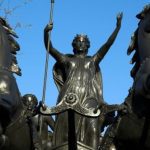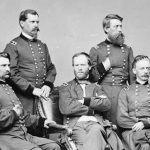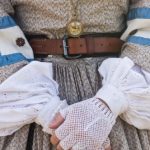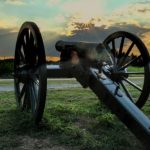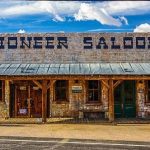 Technology
Technology  Technology
Technology  Humans
Humans 10 Everyday Human Behaviors That Are Actually Survival Instincts
 Animals
Animals 10 Animals That Humiliated and Harmed Historical Leaders
 History
History 10 Most Influential Protests in Modern History
 Creepy
Creepy 10 More Representations of Death from Myth, Legend, and Folktale
 Technology
Technology 10 Scientific Breakthroughs of 2025 That’ll Change Everything
 Our World
Our World 10 Ways Icelandic Culture Makes Other Countries Look Boring
 Misconceptions
Misconceptions 10 Common Misconceptions About the Victorian Era
 Mysteries
Mysteries 10 Strange Unexplained Mysteries of 2025
 Miscellaneous
Miscellaneous 10 of History’s Most Bell-Ringing Finishing Moves
 Technology
Technology Top 10 Everyday Tech Buzzwords That Hide a Darker Past
 Humans
Humans 10 Everyday Human Behaviors That Are Actually Survival Instincts
 Animals
Animals 10 Animals That Humiliated and Harmed Historical Leaders
Who's Behind Listverse?

Jamie Frater
Head Editor
Jamie founded Listverse due to an insatiable desire to share fascinating, obscure, and bizarre facts. He has been a guest speaker on numerous national radio and television stations and is a five time published author.
More About Us History
History 10 Most Influential Protests in Modern History
 Creepy
Creepy 10 More Representations of Death from Myth, Legend, and Folktale
 Technology
Technology 10 Scientific Breakthroughs of 2025 That’ll Change Everything
 Our World
Our World 10 Ways Icelandic Culture Makes Other Countries Look Boring
 Misconceptions
Misconceptions 10 Common Misconceptions About the Victorian Era
 Mysteries
Mysteries 10 Strange Unexplained Mysteries of 2025
 Miscellaneous
Miscellaneous 10 of History’s Most Bell-Ringing Finishing Moves
Ten Facts about the American Civil War That Few People Know
There are few things more Americans know at least a baseline of facts about than the Civil War. From 1861 to 1865, the war was fought between the North and its Union troops and the South and its Confederacy. Slavery was, of course, the significant focal point of the war, its lead-up, and its aftermath. And with a northern victory at the end of it all—despite unfathomable casualties on each side—the Emancipation Proclamation that President Abraham Lincoln had pushed forth in 1863 became the law of the land.
But besides the Civil War basics, from Fort Sumter to Gettysburg to Appomattox Courthouse, how much do you really know about the United States’ bloody internal conflict? In this list, we’ll offer up a deeper examination of ten fascinating and little-known Civil War facts that you may have missed while skimming over all those high school social studies textbooks and college history class lectures. Here is the Civil War from a deeper, more random, less commonly recognized perspective…
Related: Ten Civil War Generals Who Were Famous for Other Things
10 Hot Air Hideaway
Throughout the Civil War, both the Union and Confederate troops used hot air balloons to gather intelligence and make observations about their opponents. The Union used two main balloons in their work—the Intrepid and the Union (creative name, guys). Meanwhile, the Confederacy had one balloon they really got a lot of mileage out of: the Gazelle.
All those balloons were sent up to elevations as high as 1,000 feet (305 meters), where they were then used to point out opponent military positions and relay signs to ground troops about where to go and where to fire weapons. Obviously, having that height gave the forces a great vantage point for seeing what was up ahead and how to maneuver on the battlefield.
Of course, way back then, there was no such thing as radio communications. While having somebody high up in a balloon looking out for enemy positioning a couple miles away is great and all, what comes of it if you can’t relay that intelligence down to the ground? Well, they had a method for that, too.
In some cases, balloon operators used telegraphs to send messages down to people waiting below to interpret them. In other cases—and far more commonly—balloon riders employed the use of signal flags to indicate direction, movement, and troop numbers while being (relatively) subtle about it. This wasn’t quite spy plane technology or the Stealth Bomber, but these balloons were pretty ingenious considering the time period.[1]
9 Submarine History
At the time of the Civil War, no military anywhere in the world had perfected underwater fighting technology—yet. That all changed in 1864, though, when the Confederate Army’s H.L. Hunley submarine became the first-ever sub to sink an enemy ship in world history.
On February 17 of that year, the CSS H.L. Hunley made history with that combat achievement just off the coast of Charleston, South Carolina. There, it encountered the Union’s Housatonic, fired on it from underwater, and successfully slayed the northern ship, leaving it languishing deep in the waters off Charleston Harbor.
That’s not to say things went off without a hitch, though. The H.L. Hunley actually ran aground along the bottom of Charleston Harbor twice in the months before it managed to successfully sink the USS Housatonic. After being built in the shipyards of Mobile, Alabama, the Confederates put the Hunley into full-time use in the summer of 1863.
The South hoped it could overcome the Union’s effective blockade of Charleston. For a while, it didn’t, and it ran aground twice in mistakes that cost precious time and resources to fix. But finally, on that February 1864 day, the Hunley won what it came for when it placed the Housatonic in its sights.[2]
8 Ironclad Innovation
On March 8 and 9, 1862, the Union’s USS Monitor and the Confederacy’s CSS Merrimack duked it out in a seafaring battle. The two ships met in the harbor at Hampton Roads, Virginia, just at the very mouth of the critically important James River. There, they shot volleys at each other for about a day and a half and tried to fire upon each other’s positions to claim full control of the harbor and Hampton Roads beyond it.
Neither side won, really; the results of the battle were inconclusive, and each ship limped away. Today, the skirmish is known as the Battle of Hampton Roads. But why would it have a name and be so well-documented if neither side claimed victory and each ship moved on to future engagements?
The answer lies in how the ships were constructed. See, both the Monitor and the Merrimack were ironclad ships. And they made world history when they engaged each other out there in the harbor beyond the wide mouth of Virginia’s James River. The very act of the Monitor and the Merrimack firing on each other was the first time ever that two ironclad ships had fought each other on the water.
The world was fast-changing, and military might was growing stronger and more quickly than ever. Ironclad ships were to be the way of the future—no more of this splintered wood business. In that way, even though the Battle of Hampton Roads didn’t have a winner, the Monitor and Merrimack together altered the face of future global warfare.[3]
7 Wait, How Old?!
The youngest (known) soldier in the Civil War was a nine-year-old boy by the name of Johnny Clem, who ran away from home in Ohio to join the Union Army. Eventually, they let him tag along as a drummer boy and something of a mascot for the troops. Johnny was born with the last name “Klem” in the tiny town of Newark, Ohio, in August of 1851.
By May 1861, with his mother having died suddenly and tragically in a train accident, Johnny ran away from home. Later that year, he attempted to join the 3rd Ohio Infantry to fight against the Confederates. Unfortunately for him, he was too young and too small, so the Union Army refused him. He then fled north and tried to join the 22nd Michigan Infantry, which again refused him because of his size and age.
Undaunted, he tagged along with the 22nd Michigan for a while. Eventually, infantry leaders threw their hands up and allowed him to join in on what they were doing. They didn’t want him fighting, though. So he became an unofficial mascot and good luck charm for the unit. He also learned how to be a drummer boy for the corps. The men took to him, and officers even collectively chipped in to pay him the regular soldier’s wage—$13 a month. Two years later, just before his 12th birthday, Clem officially enlisted.
Ultimately, Clem lived a very long life, including service years later in the Spanish-American War. He died in San Antonio, Texas, in 1937 at the age of 85.[4]
6 Cold, Hard Cash
The very first time the U.S. government ever printed paper currency was during the Civil War. The new paper dollars were called “greenbacks” due to their color, and they were very much a way for the Feds up north to finance the very costly and challenging war effort. The notes were printed in green ink and sent out among the population in the hopes that they would use the currency and keep the economy afloat during the tumultuous and uprooting civil conflict.
Interestingly, the term “greenback” is actually a slang term for the paper dollars—and a derisive one at that. When the notes were first printed and distributed on a large scale in the early 1860s, northerners were very reluctant to use them. They did not have secure financial backing, and considering the unsettling state of the war, people were skeptical that the currency might just collapse.
Of course, it didn’t help that banks were mostly reluctant to give their customers the full value of the bills, either. Of course, we all know now how paper money turned out. Pretty well, we’d say! But at the time of the Civil War, it was a very new thing—and a very uncertain one.[5]
5 Stash Your Stamps!
During the Civil War, inflation absolutely soared—especially in the Confederate States. The South was trying to print up money like crazy in order to finance the war effort. Between that and the shortages of goods that inevitably came about in many places due to the war’s effect on supply lines and logistics, life suddenly became very hard (and very expensive) for the average Southerner.
In turn, their money became mostly worthless as inflation shot up to skyrocketing levels. That happened some in the North, too, as we just learned. It wasn’t like their “greenbacks” were so trusted and rock-solid, either. But in the South, inflation got so bad that a new and unlikely currency took hold across many different places desperately seeking stability.
While the war raged on, citizens quickly lost faith in all paper money. They wanted things they could handle that had real value—like gold and silver. And for a while, many people hoarded coins made of these materials, fearful they may never again have any other money. Some people even buried big glass Mason jars full of these coins. And other people went after stamps. Yes, stamps!
Stamps could be exchanged at a set amount for a specific service. So they were trusted as being an item that had actual, tangible value. Small businesses around the South quickly realized this and started using stamps to give change. People realized that, too, and began hoarding and using stamps as cash.
Things got so bad with inflation at various points during the war, and people got so desperate to be able to have something of actual value to exchange for money that the federal government finally started to recognize it, too. Newspaper magnate Horace Greeley was the first to propose a “postage currency” during the war.
On July 17, 1862, the U.S. government did just that. They created tiny paper bills that bore the illustrations of a number of stamps, the sum total of which was the bill’s denomination. It wasn’t ideal, but it worked, and for a while, many Americans used postage stamps as money at the height of the awful war.[6]
4 The Worst Day Ever
In September 1862, Confederate General Robert E. Lee marched his Army of Northern Virginia north of the Potomac River. It marked his first invasion of the North, and he was coming for Union strongholds at a breakneck pace. He wanted to draw Union forces out of their tight defense network around Washington. If they could get the Union boys out in the open, Lee figured, his men would be able to defeat them.
So, he marched north. And all across the cities of Maryland and far southern Pennsylvania, locals were terrified. They knew not what Lee’s target would be or how much damage he intended to inflict along the way. Union forces as far off as Baltimore and Philadelphia prepared their forts and battle stations for a siege.
In response, U.S. Army General George McClellan moved his Army of the Potomac out of their stronghold defenses around Washington and set out after Lee. McClellan’s men fanned out in a large area across Maryland. They hoped to give at least some protection to both Washington and Baltimore while figuring out Lee’s intentions. Over the next few weeks, there were several major battles along that front, including South Mountain and Harpers Ferry. But nothing was as brutal as the battle on the banks of Antietam Creek.
Now commonly known as the Battle of Antietam, the awful struggle took place on September 17, 1862. With both fighting forces meeting at nearly full strength, Antietam saw more than 23,000 casualties for the day. It was then, and it remains now, the single deadliest day in American war history. Antietam, more than possibly anywhere else on the map but Gettysburg, has reminded Americans of the terrible, unfathomable, and nearly incalculable costs of war.[7]
3 Did You Make That at Home?
The Civil War uniform is one of the things we all remember from school, right? The Confederates wore gray, and the Union men wore blue. Simple! Or so it should be. But as with everything in this list, the real story is a bit more complicated than that. For one, the idea that there were standard-issue uniforms on either side is actually pretty laughable.
The Union had more resources than did the Confederacy to actually provide uniforms for their men. At the very start of the war, both sides issued some semi-standard uniforms to their soldiers in the aforementioned hues. But very quickly along the way, cash ran short, resources needed to be diverted elsewhere, and new uniforms became a thing soldiers simply had to make themselves or get from clothing makers back at home—if they were lucky.
Southern soldiers were widely known for carrying a much lighter load than their northern counterparts. Optimistic Confederate sympathizers may say that’s because they were more flexible in what they needed to do and light on their feet to move quickly, and sure, that may be true. But they also simply didn’t have any money for extra items available like the Union men almost always did.
The basic Southern uniform consisted of a short-waisted jacket and simple trousers made of a very durable wool-and-cotton blend. Because of the various hues of grays and browns that the Southerners wore, which were never quite consistent or matching with their fellow soldiers on the line, the Union men called them “butternuts.” Southern soldiers often had to slog through months and years of battle on just one pair of shoes, with new treads nearly impossible to obtain during the war.
As we said, the Union men fared a little bit better. They had numerous mills up north with workers there who could mass-produce uniforms. Plus, the North had very tight connections with various nations and firms across the pond in Europe. Those countries happily traded with the Union and sent large stocks of textiles and other needs for clothing. So, in general, Union soldiers were far more uniform in their get-up than their Confederate foes.
Plus, the Union proudly rocked their blue the whole war long, especially on top. After 1862, they changed the color of their trousers to a lighter shade of blue, but the Northern soldier’s blouse forever remained a dark blue-dyed wool of strong quality. Unlike the Confederates, virtually all of them did not have their uniforms made at home.[8]
2 The Great Locomotive Chase
On April 12, 1862, one of the craziest events in the entire Civil War occurred between Atlanta, Georgia, and Chattanooga, Tennessee. That day, Union soldiers and sympathizers got hold of a train headed up to Chattanooga from the ATL and decided to use it for the Northern cause. Along the rail route north, at every stop, bridge, and telegraph exchange and station along the way, they destroyed things, ruined the tracks, broke up telegraph lines, and more.
Their aim was to completely destroy Confederate logistic and communication lines along a key piece of track between the two cities. And it worked—for a while. Confederate troops soon got wind of what was happening and began chasing them on foot. Realizing that (literally) hoofing it north from Atlanta wouldn’t let them catch the train, the Confederates first acquired a series of handcars. Then, amazingly, they got their own train, too, and the pursuit was on!
The Northern raiders eventually ran out of wood for their steam engine just south of Chattanooga. So they abandoned it and tried to flee on foot. Many escaped into anonymity, but the raid’s leader—a civilian scout named James J. Andrews—was captured with a larger group of men who had been part of the chase. Andrews and seven others were eventually hanged for their work in mucking up the Confederate train line. Still, from their perspective, the “Great Locomotive Chase,” as it came to be known, was a smashing success.[9]
1 New Mexico’s Civil War History
When you think of the Civil War, what states come to mind? Undoubtedly, you think about Virginia and Appomattox Courthouse. You should think about Pennsylvania and Gettysburg. You probably think about Maryland and Antietam. Civil War buffs no doubt think about South Carolina and Fort Sumter. And many recall Mississippi, with Vicksburg. But do you ever think of New Mexico? No? Well, you should.
On March 26, 1862, one of the most important battles in Civil War history occurred in New Mexico. Unfortunately, it’s also one of the least-known battles, especially relative to how critical it was for both Union and Confederate hopes of victory. New Mexico’s Civil War battle is officially known as the Battle of Glorieta Pass. And it is so important in the annals of Civil War history that it has come to be known unofficially as the “Gettysburg of the West.” If that doesn’t tell you how critical it is, nothing will.
It all started when Confederate soldiers based in the far Southwest, including Texas, began to take control of the United States’ then-western regions. The Texans had such success that they wanted to move into New Mexico territory. From there, the goal was to go north to Colorado and take control of gold mining camps, where they could pilfer much-needed minerals. Then, they would head to the far west and take over then-tiny and far-off seaports in Los Angeles and San Diego.
In March 1862, Confederate forces started north from Albuquerque to their planned destinations in Colorado. Several hundred went east along the Santa Fe trail, hoping to go through Glorieta Pass and turn north to paydirt. But hundreds of Union soldiers were waiting for them on the other side of the pass. The Union men repelled the Confederates, held off their charge, and put enough of a damper on westward expansion plans that the momentum was lost.
Eventually, ideas about both Colorado and California were scrapped altogether. But how different things might have been if the Confederates had gone through with it all and managed to claim SoCal’s beaches for themselves…[10]
